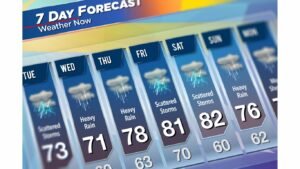Travel is an adventure and a way to connect with the world around us, but it does come with its share of unpredictability. Chief among these uncertainties are the various weather patterns that can swiftly turn your dreamy road trip or scenic mountain excursion into a daunting test of survival. For those setting out to explore the United States, being prepared for the weather’s whims is not just a precaution; it’s a travel essential.
In this comprehensive guide, we will walk you through the critical steps that can keep you safe in the face of sudden downpours, snow-covered roads, blistering heat, and more. Pack your bags with warm layers, and your mind with knowledge as we engage in an essential expedition into weather safety for U.S. travelers.
Understanding Weather Patterns in the U.S.
The United States is vast and varied, offering an array of climates settled into different regions. Weather, therefore, is far from uniform and can be quite unpredictable. Familiarizing yourself with the general patterns can be the first step to safeguarding your adventures.
Seasonal Variations and Common Weather Hazards
The US experiences four distinct seasons, each with its trademark weather risks. Summers may mean thunderstorms with a threat of lightning strikes; autumn brings about the chance of unpredictable storms, winter with its snow and ice; spring is known for flooding and tornadoes in the central plains. Coastal areas might face hurricane season, while the Southwest contends with extreme heat and dryness. Knowing which region you’re in and what to expect can give you a head start on preparation.
Essential Weather Safety Tips
Preparation is key, and here’s how you can set yourself up for safety from the moment you start planning your trip.
Packing Essentials
Travel-ready emergency kits should include items like first-aid supplies, spare chargers, a flashlight, blankets, and non-perishable food. Climate-appropriate clothing is a must, think layers and consider the worst-case-scenario temps for your destination. Footwear that suits the conditions is essential, whether that’s sturdy hiking boots or waterproof snow boots.
Planning Ahead
The more you know before you go, the better. Do your destination research well in advance: What’s the typical weather at the time of year you’re visiting? Are you going to higher altitudes where weather can change rapidly? Plan your routes, make sure your vehicle is in good working condition, and always inform someone of your itinerary.
Stay Informed
Technology has made weather updates more accessible than ever. Reliable weather apps and local alerts can keep you a step ahead of any oncoming storms. It’s not just phone apps; always ask locals about any weather patterns you should be aware of, especially if you’re in a region prone to rapid changes.
Safety Precautions
Your behavior should adapt to the weather conditions. Driving in snow may require chains or four-wheel drive, and you should always have a full tank of gas and emergency supplies in your vehicle. If you’re trekking, think about how the weather can affect your trails, water resources, and wildlife.
Specific Weather Scenarios and Actions
While general tips can be incredibly helpful, specific scenarios require specific knowledge and actions. Here’s what you need to know for various weather challenges.
Thunderstorms and Lightning
Seek shelter indoors or in a hard-topped vehicle, avoid high grounds, and take cover in a low-lying area if you’re outside and cannot reach a structure. Never take shelter under a lone tree, it’s a lightning rod. If someone is struck, CPR may be necessary, ensure you have wilderness first-aid knowledge or be close to help.
Winter Conditions and Snowstorms
Visibility is often low during snowstorms, and roads can become treacherous. If conditions worsen, pull over safely and wait it out. If you’re on foot, visibility tools like reflective clothing are a must. Frostbite and hypothermia are real risks, so protect your skin and carry warm, waterproof clothing.
Hurricanes and Tropical Storms
If local authorities issue an evacuation order, follow it. Before the storm, stock up on essentials, secure loose outside items, and board up windows if you can. During the storm, stay indoors, away from windows and glass doors, preferably in an interior room or hallway. Have a plan for after the storm as well, including contacting loved ones to assure them you’re safe.
Heatwaves and Extreme Temperatures
Hydration is key during heatwaves, but it’s not just water; electrolytes are crucial in high heat. Wear loose, light-colored clothing and use shade, hats, and sunblock to shield yourself. Limit outdoor activities and use the cooler times of the day for travel.
Emergency Response and Resources
Sometimes, despite our best efforts, we find ourselves in the middle of a weather-related emergency. Here’s how to handle the situation.
What to Do in Emergencies
Stay calm, first of all. Assess your situation and take appropriate actions – this can range from sheltering in place to seeking higher ground in a flood. Prepare to wait out the weather event or to signal for help if you’re in a remote location.
Contacting Authorities and Seeking Help
Local emergency numbers vary by location, but 911 is a universal number for medical, police, and fire emergencies across the U.S. When in doubt, call for help. It’s important to have an emergency communication plan as well, making sure someone knows to trigger help if you can’t.
Conclusion
Weather safety is not something to be overlooked or taken lightly. No adventure is worth sacrificing your well-being. By embracing these safety tactics and insights, you’re not only enhancing your own travel experience but also setting a positive example for fellow adventurers. Now, go forth and explore, knowing that the skies may change, but your preparedness will remain steadfast.
Remember to check the local weather advisories and rethink any plans that might put you or others at risk. Happy and safe travels across the magnificent terrains of the United States.


